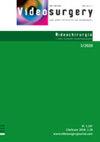电视胸外科手术中锯肌前平面阻滞与椎旁神经阻滞镇痛效果的比较:一项随机对照试验
IF 1.6
4区 医学
Q2 SURGERY
引用次数: 4
摘要
接受视频辅助胸外科手术(VATS)的患者经常经历中度至重度术后疼痛。Serratus anterior plane block (SAPB)是一种较新的阻断肋间神经外侧皮支和胸长神经的技术。目的评价深锯肌平面阻滞(DSPB)、浅锯肌前平面阻滞(SSPB)及椎旁神经阻滞(PVB)对VATS患者的镇痛效果。材料与方法74例年龄16-80岁的VATS患者随机接受DSPB或SSPB以及PVB治疗。术前按患者分组分别行超声引导下的DSPB或SSPB及PVB。所有患者均给予患者自控静脉镇痛(PCIA)用于术后镇痛。主要结局是通过视觉模拟评分(VAS)评估术后静息疼痛和咳嗽水平,以及术中和术后阿片类药物的消耗。次要观察指标包括PCIA按压次数、副作用及镇痛满意度、神经阻滞时间、术中血流动力学变化及血管活性药物用量。结果两组VAS评分差异无统计学意义。在手术过程中,PVB比DSPB(31.20±3.80 mg)和SSPB(32.61±5.28 mg)减少阿片类药物的消耗(27.23±5.10 mg)。术后12 h, SSPB组PCIA有效按压次数(0.18±0.65)明显低于PVB组(1.09±1.50)。与PVB(31.45±7.60 ml)相比,SSPB也减少了PCIA的剂量(26.55±4.72 ml)。PVB手术时间(11.14±1.66 min)高于DSPB(5.68±1.10 min)和SSPB(4.77±1.04 min)。结论DSPB和SSPB操作简便,可作为PVB的替代技术,对VATS患者具有相当的镇痛效果。本文章由计算机程序翻译,如有差异,请以英文原文为准。
A comparison of the analgesic efficacy of serratus anterior plane block vs. paravertebral nerve block for video-assisted thoracic surgery: a randomized controlled trial
Introduction Patients who undergo video-assisted thoracic surgery (VATS) frequently experience moderate to severe postoperative pain. Serratus anterior plane block (SAPB) is a relatively novel technique that can block the lateral cutaneous branches of the intercostal nerves as well as the long thoracic nerve. Aim To evaluate the analgesic efficiency of deep serratus plane block (DSPB) and superficial serratus anterior plane block (SSPB) as well as paravertebral nerve block (PVB) in patients undergoing VATS. Material and methods A total of 74 patients aged 16–80 undergoing VATS were randomized to receive either DSPB or SSPB as well as PVB. Ultrasound (US) guided DSPB or SSPB as well as PVB was performed preoperatively on the patients according to their groups. All patients were provided with patient-controlled intravenous analgesia (PCIA) for postoperative analgesia. The primary outcomes were the levels of postoperative pain at rest and on coughing evaluated by the visual analog scale (VAS), and intraoperative and postoperative opioid consumption. The secondary outcomes included PCIA pressing times, side effects and satisfaction with analgesia, duration of nerve block, intraoperative hemodynamic changes and vasoactive drug dosage. Results No significant differences of VAS score were found. During the operation, PVB reduced consumption of opioids (27.23 ±5.10 mg) compared to DSPB (31.20 ±3.80 mg) and SSPB (32.61 ±5.28 mg). The effective pressing times of PCIA in the SSPB group (0.18 ±0.65) were significantly lower compared to the PVB group (1.09 ±1.50) at 12 h postoperatively. Accordingly, SSPB also reduced the dosage of PCIA (26.55 ±4.72 ml) compared to PVB (31.45 ±7.60 ml). Time of the PVB procedure was longer (11.14 ±1.66 min) than DSPB (5.68 ±1.10 min) and SSPB (4.77 ±1.04 min). Conclusions DSPB and SSPB are easy to perform and can serve as a promising alternative technique to PVB that may offer comparable analgesic effectiveness for patients undergoing VATS.
求助全文
通过发布文献求助,成功后即可免费获取论文全文。
去求助
来源期刊
CiteScore
2.80
自引率
23.50%
发文量
48
审稿时长
12 weeks
期刊介绍:
Videosurgery and other miniinvasive techniques serves as a forum for exchange of multidisciplinary experiences in fields such as: surgery, gynaecology, urology, gastroenterology, neurosurgery, ENT surgery, cardiac surgery, anaesthesiology and radiology, as well as other branches of medicine dealing with miniinvasive techniques.

 求助内容:
求助内容: 应助结果提醒方式:
应助结果提醒方式:


